
|

Meet Sandy. He's a Scottish robot who plays the bagpipes here in Polydelphia. He also has a shop where he sells them. Sandy is right at home here in our town, because almost every part of a bagpipe is POLYMERS! |

|
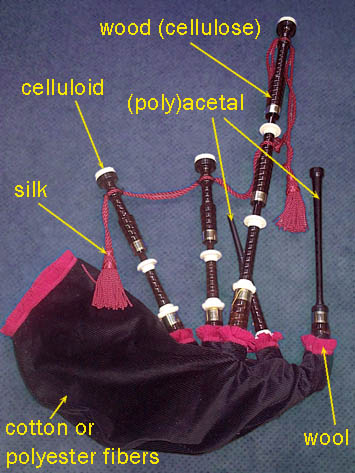
Here you can see a diagram of many of the polymers that are really in a bagpipe.
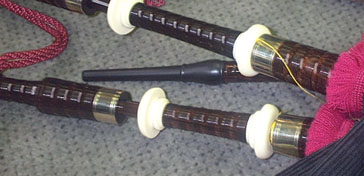 One of the main polymers is wood. It is what all the big drone pipes are made from. Wood is a natural polymer called cellulose.
One of the main polymers is wood. It is what all the big drone pipes are made from. Wood is a natural polymer called cellulose.
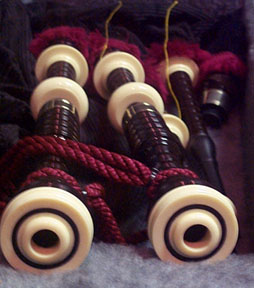 The pretty ivory parts of the pipes are not really ivory at all. They are made from celluloid, a type of plastic. Real ivory on older bagpipes is a type of protein, like the stuff that fingernails and hair are made of. But the plastic ivory looks so nice these days that it looks like it might come from the tusks of plastic elephants!
The pretty ivory parts of the pipes are not really ivory at all. They are made from celluloid, a type of plastic. Real ivory on older bagpipes is a type of protein, like the stuff that fingernails and hair are made of. But the plastic ivory looks so nice these days that it looks like it might come from the tusks of plastic elephants!
 And the thing that makes it a bagpipe - the bag - is made of leather. You usually can't see it becasue it is under that pretty bag cover, so here's a picture of it. Like cellulose, leather is also a natural polymer, formed from protein.
And the thing that makes it a bagpipe - the bag - is made of leather. You usually can't see it becasue it is under that pretty bag cover, so here's a picture of it. Like cellulose, leather is also a natural polymer, formed from protein.
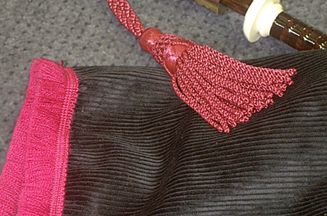 The bag cover is fabric made from cotton fibers, more cellulose. Velvet covers may be made of polyester or other artificial fibers. And that cool fringe is made from wool, which is another natural polymer. The neat cords that hold all the drones together and look like something from a fancy set of curtains are made of silk, one more natural polymer! They can also be made of wool. By the way, wool and silk are both proteins.
The bag cover is fabric made from cotton fibers, more cellulose. Velvet covers may be made of polyester or other artificial fibers. And that cool fringe is made from wool, which is another natural polymer. The neat cords that hold all the drones together and look like something from a fancy set of curtains are made of silk, one more natural polymer! They can also be made of wool. By the way, wool and silk are both proteins.
 Another important part of the bagpipe is the chanter, which is the part that the piper plays. Many are made from wood, but this chanter is made from polyacetal, a tough plastic that can be cut and drilled and shaped a lot like wood, but is not as delicate. The mouthpiece on the blowpipe - where the air is blown into the bag, is also made of polyacetal plastic.
Another important part of the bagpipe is the chanter, which is the part that the piper plays. Many are made from wood, but this chanter is made from polyacetal, a tough plastic that can be cut and drilled and shaped a lot like wood, but is not as delicate. The mouthpiece on the blowpipe - where the air is blown into the bag, is also made of polyacetal plastic.
But wait! There's more!
You can't forget the polymers INSIDE a bagpipe. The polymers inside are the ones that make sound.
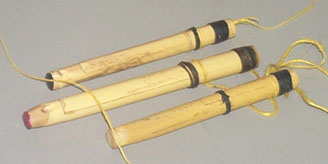 The sounds a bagpipe make - hopefully good sounds - come from vibrating reeds. There is a reed in each drone, and in the chanter. Reeds are made from a tough plant called cane. Cane, which is much the same as bamboo, is a member of the grass family. Cane even grows in patches like grass, and like all other plants, cane is cellulose.
The sounds a bagpipe make - hopefully good sounds - come from vibrating reeds. There is a reed in each drone, and in the chanter. Reeds are made from a tough plant called cane. Cane, which is much the same as bamboo, is a member of the grass family. Cane even grows in patches like grass, and like all other plants, cane is cellulose.
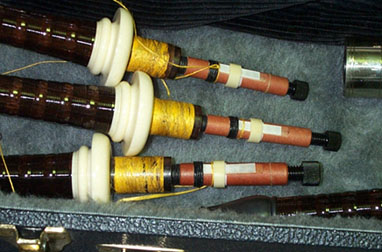
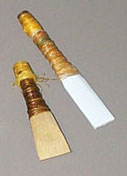 Here's a set of artificial reeds. The bodies are made of cellulose, and the vibrating tongues are nylon. The bands used to tune them are rubber, another natural polymer. And look at these chanter reeds. These can be made from cane or polyethylene - a common plastic. The plastic ones are a lot like a reed made from a drinking straw.
Here's a set of artificial reeds. The bodies are made of cellulose, and the vibrating tongues are nylon. The bands used to tune them are rubber, another natural polymer. And look at these chanter reeds. These can be made from cane or polyethylene - a common plastic. The plastic ones are a lot like a reed made from a drinking straw.
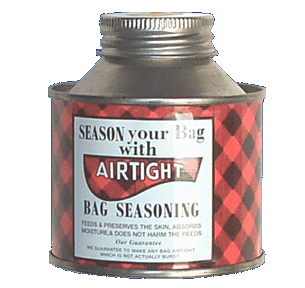 A pretty weird polymer that goes inside the bag a couple times a year is seasoning. This mixture of proteins helps to plug up any small holes in the bag and keep it airtight. That's why this stuff is called "Airtight"!
A pretty weird polymer that goes inside the bag a couple times a year is seasoning. This mixture of proteins helps to plug up any small holes in the bag and keep it airtight. That's why this stuff is called "Airtight"!
 And here is more cellulose - yellow string made from hemp. Ths string is very strong and is used to seal the joints where the pipes are stuck together. You can see it above in the picture of the drone reeds. Wax - a polymer made by bees - is used to hold the hemp together and to keep the string from getting too moist. Soggy string can swell up and cause the pipes to get stuck or crack. And a piper's lungs make a lot of moisture!
And here is more cellulose - yellow string made from hemp. Ths string is very strong and is used to seal the joints where the pipes are stuck together. You can see it above in the picture of the drone reeds. Wax - a polymer made by bees - is used to hold the hemp together and to keep the string from getting too moist. Soggy string can swell up and cause the pipes to get stuck or crack. And a piper's lungs make a lot of moisture!
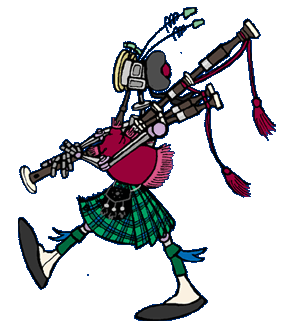 Now that you know something about bagpipes, try the interactive bagpipe. This needs a Flash player. If your computer doesn't have one, it will let you know how to get it.
Now that you know something about bagpipes, try the interactive bagpipe. This needs a Flash player. If your computer doesn't have one, it will let you know how to get it.
Also try the Flash interactive bagpipe shop. Here there are more details on the polymers in a bagpipe, including more sounds and interesting facts.

|
Return to Where are Polymers |

|
Return to Main Page |